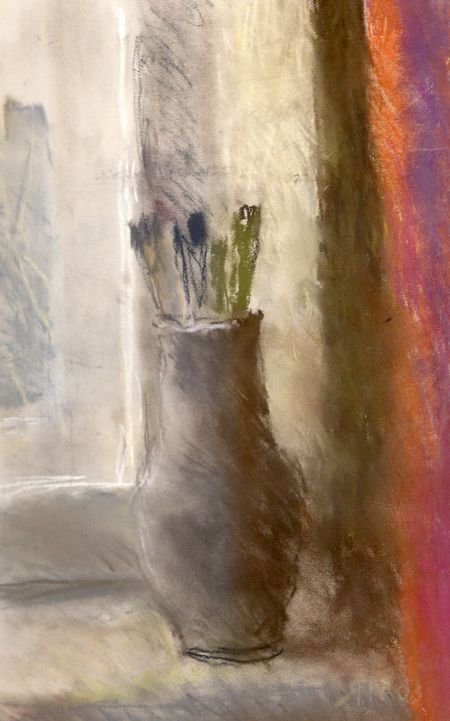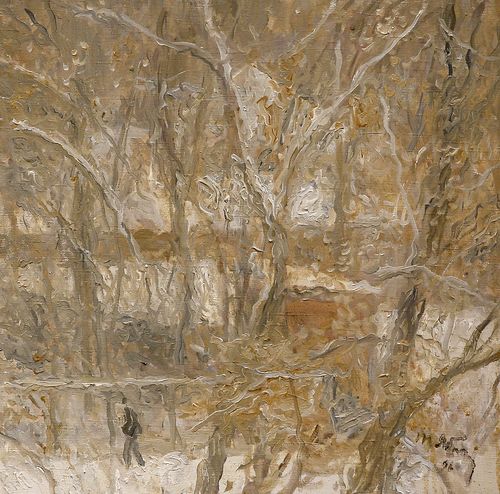The Museum of the Book and Printing of Ukraine is hosting the exhibition “Listening to One’s Own Self,” which shows the artist’s oil paintings and pastels, until March 12.
Tetiana Yablonska, the best known mid-to-late-20th-century Ukrainian artist, would have been 101 on February 24. A number of events, organized with active participation of Gayane Atayan, the younger daughter and the main custodian of the artist’s legacy, began in Kyiv on Tetiana Day, January 25.
In particular, the National Museum of Ukrainian Literature presented a rarity – A Destroyed Book by Tetiana Yablonska and Ivan Drach, – republished by Mystetstvo. In 1969 this album with a circulation of 4,000 copies, which comprised the best ballads of Drach and reproductions of Yablonska’s pictures, was destroyed on a charge of “nationalism.” Only two advance copies have survived. One of them, which belonged to Yablonska and bears her own notes in pencil, was reproduced.

The circulation of 5,000 “plus another 100 books” were immediately sent to libraries. Only a few copies were on sale. During this event, one could buy this rarity, take Ivan Drach’s autograph, hear reminiscences about Yablonska from such masters of fine arts as Andrii Chebykin, Volodymyr Chepelyk, and Anatolii Melnyk, the legendary director of the Mystetstvo publishing house Nina Prybieha, literature expert and longtime dean of Kyiv Taras Shevchenko National University’s Faculty of Philology Myhailo Naienko, and other luminaries of today.
On the anniversary of the birth of the painter, on whose works Ukrainians of various ages grew up, most of the best-known contemporary artists either consider her their immediate teacher or otherwise show gratitude to Yablonska for their “way in art.” For example, there was a crowded memorial evening at Kyiv’s Pavlo Tychyna Museum-cum-Apartment. The audience could see Stanislav Suknenko’s documentary film Tetiana Yablonska: Inspiration of Loneliness (2008) and discuss it with Gayane Atayan.
It is possible to get acquainted with the strong-spirited artist’s oeuvre at the Museum of the Book and Printing of Ukraine which is displaying Yablonska’s pictures. The exhibit “Listening to One’s Own Self” occupies two halls. One of them shows the pastels the artist created in the last years of her life. After a stroke, Yablonska could no longer paint in oils and mastered a new technique of pastels. This technique is now very popular in China because, by its philosophicalness and profundity, outward laconism, and subject figures (a lonely plant or even onion, the bright flash of a flower against the dark background, and other lyrical images), it quite fits in with the “oriental” world-view. It is the Ukrainian Tao and Zen – wise, gained through much suffering, not “invented.”

The other, larger, hall displays Yablonska’s oil paintings in the penultimate period of her artistic work. It was an impressionist phase, when no ideological barriers stood in the way of the artist’s grand talent, and no communist ideologues – “in charge of art” – could any more dictate what kind of art should be created. Painted mostly at a dacha in her beloved Sedniv in the late 1980s – the 1990s, the pictures astonish you with the riot of life and emerald greenery. They seem to be alive. Each looks like an impersonation of hope.
At the beginning of independence and in the later years, Tetiana Yablonska associated her expectations for the better with freedom, renaissance, and a happy future of Ukraine to which she was devoted with all her heart. These hopes of the artist, her faith and expectations, are still charging us with a living energy today.







